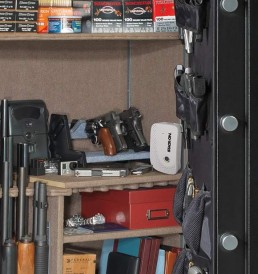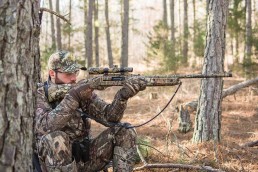Plenty of Options for Safe Gun Storage
SHARE THIS POST
We can all pretty much agree that the days of wall-mounted horizontal gun racks or gun cases fitted with etched glass doors are gone. In the 21st Century, firearms storage is more about security than display. We don’t really get to show off our guns these days. We take them to the range. We take them hunting. Then we put them away. Considering how much time our firearms spend in storage, it’s important that we put some thought into how and where we store them.
Under lock and key
If storage is about security, the place to start is with how you’ll keep your firearms from falling into the wrong hands. That euphemism, “falling into the wrong hands,” sounds so much better than saying we don’t want our guns to be operated by any unauthorized users. But that’s the truth. Trigger locks, cable locks, lock boxes, gun safes and vault doors that protect entire gun rooms exist for one reason: to ensure only those allowed to handle your guns get to do so. Whatever level of security you choose, the goal is the same.
Trigger locks can be complicated or simple. They simply ensure a firearm can’t be fired, but don’t offer any real security. A thief could carry away a firearm equipped with a trigger lock, so they don’t really count as a storage option. But a cable lock, one that is run through an open action, can also be looped through an eye bolt secured to a wall. This offers only a minimal level of security, but may discourage a thief who is in a hurry.
Lock boxes come in all shapes and sizes, but powder-coated steel seems to be the most common material used in the creation of decent quality boxes. Look for welded seams and piano style hinges. Tubular locks provide the most security, but remember they are only as good as the locking lugs behind them. Boxes designed for long guns will typically have two locks. Handgun boxes only have one. Seams, locking points and hinges are the pry points for thieves. The stronger the points, the longer it will take for a thief to get in. No lock box is impenetrable but choosing a well-built box and mounting it securely to both the wall and the floor will really improve security. Opt for 3-inch lag screws for the wall mounts and at least 1 1/2-inch lag screws to anchor the unit to the floor.
Gun safes: real security
Gun safes offer an enhanced level of security, both in their locking mechanism and in the area of fire rating. With a gun safe, the sky is the limit on everything from locking mechanism (mechanical or electronic), to interior organization, to size and cost.
Shopping for a safe is an exercise in research. First, decide what elements you want in your safe. You will be able to choose every element, from the style of the combination lock to the fire rating, which is a time and temperature rating. The longer the time and higher the temperature rating noted in the specs, expect to pay more. But if you own guns you can’t replace, you want the higher ratings.
Delivery and installation
One of the most important elements of buying a safe is to have a firm understanding of where your safe will live and how you’ll get the safe to its new location. Considering the safe will weigh several hundred pounds, you will not only be investing in the safe, but also installation and delivery. Yes, you can enlist a group of buddies to haul that monster around, but a moving company will save you lots of headaches. Also, depending on the location you choose for your safe, you might need to reinforce flooring or provide some other types of supports in the area directly beneath the safe.
If you choose an electronic locking mechanism, pay attention to battery life and consider a safe that has some type of keyed backup system to provide access. The last thing you want is to be locked out of your own safe. Whether you choose a safe with an electronic PIN pad or an old-fashioned dial combination, put those digits somewhere safe. All of us have, at one time or another, forgotten a combination to a very important lock. My locksmith charges $100 to just pay me a visit, and more to work his bonded magic on the door of a gun safe.
Choose your location
The basement only works for storage if you take extra steps to control humidity. If that is the only place you have room for firearms storage, you’ll need to focus on controlling the moisture. Stack-On offers an array of moisture-control tools, from desiccant packs to battery-operated, rechargeable, and electronic dehumidifiers. If humidity is a concern due to location or climate, arm your safe with enough air-drying power to protect your guns. With rechargeables and desiccants, you have to be religious about recharging them. Mark your calendar. Set a computer reminder. Just make sure you take care of it on schedule.
Most gun safes are built with access for an electrical cord. Many gun boxes will require “modification.” If you choose to do this, do it carefully. Drilling into a gun box could void the warranty, but more importantly you will want to make sure that when dealing with electrical appliances and metal boxes, everything is in order.
Are you enjoying this post?
You can be among the first to get the latest info on where to go, what to use and how to use it!
Cleaning before storage
You aren’t going to put your guns away dirty, are you? While cleaning and maintenance should be a completely separate story, the cleaning part of the equation is very important before storing a firearm away for any length of time. Thoroughly clean your firearms before storage, especially long-term storage. Before putting guns away, apply a thin coat of protectant to help prevent rust. But more important than cleaning your guns properly is how you handle them as you put them away. Once the guns are clean, don’t touch the metal. Several times, I have returned to a gun safe to find a beautiful thumbprint rusted on the tang of a firearm because I grabbed the gun with my bare hand to put it into storage. Most of the time, the rust came off with some oil and 0000 steel wool. But I have learned my lesson. Now, after the guns are cleaned and coated with protectant, I only handle them with a rag as I put them into storage. This ensures they stay rust-free even if I don’t use them for months.
Remember, firearms storage is second only to gun handling when it comes to safety. Keeping your guns away from those who should not be using them is the best way to ensure everyone is safe.
Kevin Michalowski is a longtime firearms and hunting writer from Wisconsin where he enjoys upland bird, waterfowl and deer hunting. His exploits have taken him across the Lower 48 with Alaska and Africa on the bucket list.
5 Tips for effective firearms storage:
- Store firearms unloaded
This is a safety and maintenance issue. If you don’t unload and clean your firearm, especially a bolt- or lever-action rifle, before you put it away, you run the risk of returning to find a seized action.
- Store guns and ammo separately
This is Firearms Safety 101 and should need no further explanation. Storing guns and ammo separately is the best way to keep unauthorized people from using your gun.
- Clean guns before storage
If you take it out of the gun safe, wipe it down before you put it away. If you fire it, even once, clean it thoroughly and apply a thin coat of protectant. Follow the instructions provided with your owner’s manual. If you don’t have an owner’s manual you can likely find one online.
- If possible, store ‘em muzzle down
Storing long guns muzzle down allows residual solvents or oils to drain away from the action––and, even more importantly––away from the stock. Oil and solvents can soak into wooden stocks and weaken them. It can take years, but how long do you expect to own that gun?
- Use technology
Desiccant packets, air-circulation systems, and other humidity-control equipment can all help keep your guns in good condition as they rest in the safe. Don’t overlook the importance of using technology to keep your guns rust free. Just don’t overdo it. Air that is too dry can be bad for your stocks.
Did you enjoy this post?
You can be among the first to get the latest info on where to go, what to use and how to use it!
Kevin Michalowski
MidWest Outdoors works with more than 200 outdoor experts each year, who contribute articles based on their areas of expertise. MidWest Outdoors magazine offers more fishing and hunting articles than any other publication!


